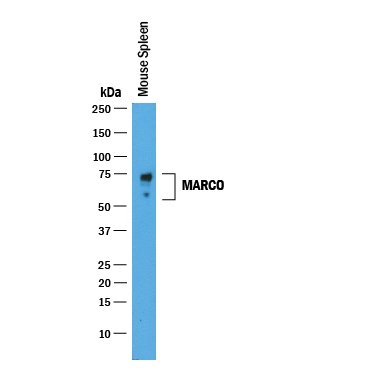Mouse MARCO Antibody Summary
Gln70-Ser518
Accession # Q60754
Applications
Please Note: Optimal dilutions should be determined by each laboratory for each application. General Protocols are available in the Technical Information section on our website.
Scientific Data
 View Larger
View Larger
Detection of Mouse MARCO by Western Blot. Western blot shows lysates of mouse spleen tissue. PVDF membrane was probed with 0.25 µg/mL of Goat Anti-Mouse MARCO Antigen Affinity-purified Polyclonal Antibody (Catalog # AF2956) followed by HRP-conjugated Anti-Goat IgG Secondary Antibody (Catalog # HAF019). Specific bands were detected for MARCO at approximately 65-75 kDa (as indicated). This experiment was conducted under reducing conditions and using Immunoblot Buffer Group 1.
Reconstitution Calculator
Preparation and Storage
- 12 months from date of receipt, -20 to -70 °C as supplied.
- 1 month, 2 to 8 °C under sterile conditions after reconstitution.
- 6 months, -20 to -70 °C under sterile conditions after reconstitution.
Background: MARCO
MARCO (macrophage receptor with collagenous structure), also known as SCARA2, is an 80 kDa type II transmembrane glycoprotein that belongs to the class A scavenger receptor family (1). Mouse MARCO consists of a 48 amino acid (aa) cytoplasmic domain, a 21 aa transmembrane segment, and a 449 aa extracellular domain (ECD) that includes a stalk region, a collagen-like region, and one SRCR domain (2). Within the ECD, mouse MARCO shares 69% and 86% aa sequence identity with human and rat MARCO, respectively. It shares 18%‑28% aa sequence identity with other mouse class A scavenger receptors CL-P1, SCARA3, SCARA5, and SR-A1/MSR. MARCO is constitutively expressed on the surface of splenic and lymph node macrophages (2, 3). Its expression is induced on Kupffer cells and alveolar macrophages by microbial infection, chemical irritants, and Th1 polarizing factors (3‑5). MARCO binds LPS, lipoteichoic acid, and other determinants on Gram positive and Gram negative bacteria (2, 6‑8). It also binds modified LDL, CpG oligonucleotides, UGRP1, silica, and TiO2 (2, 9‑11). MARCO is required for the organization of the splenic marginal zone and the interaction of local macrophages and B cells (12, 13). The SRCR domain mediates binding of MARCO to its various ligands (3, 12), while the collagen-like region mediates assembly into a disulfide-linked trimeric molecule (2, 7). MARCO ligation induces, but is not required for the production of IL-12, NO, or TNF-alpha by macrophages (5, 6, 9). MARCO knockout mice show a reduced clearance of bacterial infections, reduced mast cell mediated silicosis, increased pulmonary inflammation, and increased sensitivity to ozone induced lung damage (4, 9, 14‑16).
- Murphy, J.E. et al. (2005) Atherosclerosis 182:1.
- Elomaa, O. et al. (1995) Cell 80:603.
- Van der Laan, L.J.W. et al. (1999) J. Immunol. 162:939.
- Dahl, M. et al. (2007) J. Clin. Invest. 117:757.
- Jozefowski, S. et al. (2005) J. Immunol. 175:8032.
- Mukhopadhyay, S. et al. (2006) Eur. J. Immunol. 36:940.
- Sankala, M. et al. (2002) J. Biol. Chem. 277:33378.
- Chen, Y. et al. (2006) J. Biol. Chem. 281:12767.
- Jozefowski, S. et al. (2006) J. Leukoc. Biol. 80:870.
- Bin, L.-H. et al. (2003) J. Immunol. 171:924.
- Hamilton, Jr. R.F. et al. (2006) J. Biol. Chem. 281:34218.
- Karlsson, M.C.I. et al. (2003) J. Exp. Med. 198:333.
- Chen, Y. et al. (2005) J. Immunol. 175:8173.
- Arredouani, M. et al. (2004) J. Exp. Med. 200:267.
- Arredouani, M.S. et al. (2007) J. Immunol. 178:5912.
- Brown, J.M. et al. (2007) Am. J. Respir. Cell Mol. Biol. 36:43.
Product Datasheets
Citations for Mouse MARCO Antibody
R&D Systems personnel manually curate a database that contains references using R&D Systems products. The data collected includes not only links to publications in PubMed, but also provides information about sample types, species, and experimental conditions.
3
Citations: Showing 1 - 3
Filter your results:
Filter by:
-
Aging-Impaired Filamentous Actin Polymerization Signaling Reduces Alveolar Macrophage Phagocytosis of Bacteria
Authors: Z Li, Y Jiao, EK Fan, MJ Scott, Y Li, S Li, TR Billiar, MA Wilson, X Shi, J Fan
J. Immunol., 2017-09-25;0(0):.
Species: Mouse
Sample Types: Whole Cells
Applications: ICC -
Role of lysosomes in silica-induced inflammasome activation and inflammation in absence of MARCO.
Authors: Biswas R, Hamilton R, Holian A
J Immunol Res, 2014-06-26;2014(0):304180.
Species: Mouse
Sample Types: Whole Cells
Applications: Neutralization -
Identification of an IFN-gamma/mast cell axis in a mouse model of chronic asthma.
Authors: Yu M, Eckart MR, Morgan AA, Mukai K, Butte AJ, Tsai M, Galli SJ
J. Clin. Invest., 2011-08-01;121(8):3133-43.
Species: Mouse
Sample Types: Cell Culture Supernates
Applications: ELISA Development
FAQs
No product specific FAQs exist for this product, however you may
View all Antibody FAQsReviews for Mouse MARCO Antibody
There are currently no reviews for this product. Be the first to review Mouse MARCO Antibody and earn rewards!
Have you used Mouse MARCO Antibody?
Submit a review and receive an Amazon gift card.
$25/€18/£15/$25CAN/¥75 Yuan/¥2500 Yen for a review with an image
$10/€7/£6/$10 CAD/¥70 Yuan/¥1110 Yen for a review without an image


